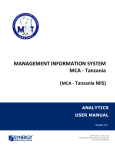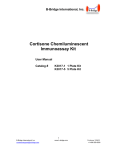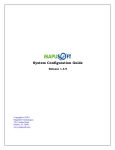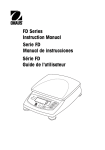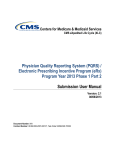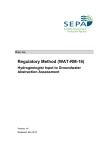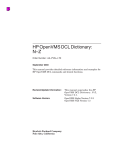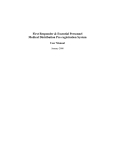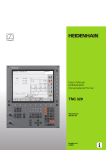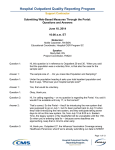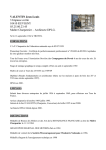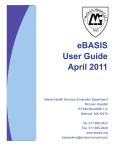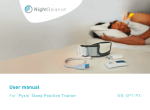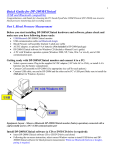Download Presentation Transcript_508
Transcript
Hospital Outpatient Quality Reporting Program Moderator: Marty Ball, RN Educational Coordinator, Hospital OQR Program SC Speakers: Marty Ball, RN Educational Coordinator, Hospital OQR Program SC Butch Miller, MA, RN Project Coordinator, Hospital OQR Program SC March 21, 2012 PRESENTATION Operator: Good afternoon, ladies and gentlemen, and thank you for waiting. Welcome to the Hospital Outpatient Quality Reporting Program Educational Webinar. All lines have been placed on listen-only mode, and the floor will be open for your questions and comments following the presentation. Due to the large volume of attendees, during the question-and-answer session you will be muted after your initial questions and comments. As a reminder, if you have muted your telephone now, please unmute as it, as your line is automatically muted. Without further ado, it is my pleasure to turn the floor over to your host, Mr. Marty Ball. Mr. Ball, the floor is yours. Marty Ball: Thank you, Amanda. Hello, everyone. Welcome, and thank you for joining us today for the Hospital OQR educational webinar. My name is Marty Ball, and I'm the educational coordinator for the Hospital OQR team. Today's webinar we will announce CMS's decision to suspend the transition record, OP-19, and we will review the abstraction of times associated with chart validation. Page 1 of 18 5201 W. Kennedy Boulevard, Suite 900 • Tampa, Florida 33609 • 813-354-9111 • 813-354-0737 fax www.fmqai.com Hospital Outpatient Quality Reporting Program Before we get started, I have a few announcements I would like to make. The next clinical data submission deadline will be on May 1 for quarter four of 2012. Please monitor your OPPS Clinical Warehouse Feedback Reports and your Hospital OQR Provider Participation Report available through your secure My QualityNet account. These reports enable you to verify whether your data you or your vendor submitted has been accepted into the OPPS Clinical Warehouse. Please remember that hospitals are responsible for ensuring that their HOP QDRP requirements are met. Also, please check for submission of duplicate records in the Quality Net Reports. The duplicate records can cause a problem if the chart is requested twice for validation. The release of the Case Selection Reports for validation have been delayed by QualityNet, but can be available now from your QIOs. Expect to see the report on QualityNet after the first week in April. There have been roughly 400 hospitals that have re-signed their OPledge form. It is not necessary to do this. QualityNet is working on the problem to clear the confusion that hospitals think they must re-pledge. Hospitals that have been validated received their request from CDAC for records in February for quarter three in 2011. These records are due back to CDAC no later than April 9, or 45 days from when your hospital received the request from CDAC. Expect fourth quarter record requests towards the end of May. Page 2 of 18 5201 W. Kennedy Boulevard, Suite 900 • Tampa, Florida 33609 • 813-354-9111 • 813-354-0737 fax www.fmqai.com Hospital Outpatient Quality Reporting Program There will be a short program satisfaction evaluation sent out via email. Please take a moment to provide us with your valuable feedback. Please do not use the chat feature on your screen. We do not monitor that area for questions. At the end of the presentation we will have a question-and-answer session until the top of the hour. This webinar is being recorded. I'd like to introduce our speakers today. Myself and Butch Miller will be giving today's presentation. Mr. Miller helped create the Hospital OQR program and he is an expert in assisting the hospitals and understanding the measures and technicalities of the program. Butch Miller: Thank you, Marty. Some of you may have figured out that something happened with Outpatient-19. Outpatient-19 was suspended by CMS for the time being and is being reworked by the American Medical Association, who originated the measure, and CMS, because of all the issues that were raised with your comments and questions. You are still going to have to answer the question in whatever abstraction tool you are using or the record will be rejected by the warehouse. Your abstracted answer for Outpatient-19 will not be validated, will not be published on Hospital Compare, and will not affect your payment in any way. So, some of you who were waiting to hear what happened and are really good at admission and discharge can go back to work and we'll talk to the rest of the folks. Page 3 of 18 5201 W. Kennedy Boulevard, Suite 900 • Tampa, Florida 33609 • 813-354-9111 • 813-354-0737 fax www.fmqai.com Hospital Outpatient Quality Reporting Program Marty Ball: Right. So, today we're going to cover arrival and departure time as it relates to validation requirements, including ECG time and face sheet time. Hospitals can document the initial arrival time in many different ways. A patient may walk into the ED and first see a volunteer, who tells the patient that they have chest pain and they may go straight to the triage nurse, who establishes the time at that point. Or, the volunteer may get the name of others and have them sit down and wait their turn, so they may next go see the registration clerk, and at that time the time is established. Or another emergency department may have a time stamp machine for the patient to establish when they arrive. If the stamp becomes part of the permanent ED record, then that could be the time when the patient first physically arrives to the ED. It's the abstractor's job to establish the time when the patient arrived, and it's the quality improvement person's job to make this abstraction easy and consistent by meeting with the ED staff and informatics. Any part of the ED record can be used. If the patient walks through the door and complains of chest pain and an ED tech is there to immediately get an ECG, the time stamp on the ECG may become the earliest arrival time. Be sure to not use outside resources, such as the EMS run sheet, which may have an arrival time to the facility on it. For surgical patients, OP-6 and -7, arrival time is not used for validation. It is used to differentiate cases that may be on the same Page 4 of 18 5201 W. Kennedy Boulevard, Suite 900 • Tampa, Florida 33609 • 813-354-9111 • 813-354-0737 fax www.fmqai.com Hospital Outpatient Quality Reporting Program date. So, for arrival time for surgical patients, OP-6 and -7, use the earliest time the patient arrives the day of the procedure. Then we have some examples. In this example, the patient arrives to the ED with chest pain. An ECG is immediately obtained and the machine stamp time is 13:59. The nurse then triages the patient at 14:00, obtains vital signs, and then the patient is registered. Using the earliest time, the ECG machine stamp time becomes the first time. And be sure that when time includes seconds to remove the seconds and record the time as it is -- in this case, 13:59. In this scenario the patient is preregistered by the ED admission people. When CDAC extracts the chart, they are not going to realize that the patient was preregistered, or has been preregistered, so the hospital would want to abstract the earliest time. And if the face sheet says arrival time, then you're going to want to abstract that time, which would be 07:10 in this example. In this example, the first apparent time the patient physically arrived to the ED is the recorded blood pressure time. For the ECG done in the ambulance, time will become the admission time, which the admission time in this example is 14:19. The triage note and the face sheet are both recorded after the blood pressure, so the BP being the initial time that the patient was seen. I'd like to turn the program back over to Butch now. Butch Miller: ED departure time. What we are looking for here is the time the patient physically leaves the ED, whether they're going home, whether they're going up to the floor, whether they're being Page 5 of 18 5201 W. Kennedy Boulevard, Suite 900 • Tampa, Florida 33609 • 813-354-9111 • 813-354-0737 fax www.fmqai.com Hospital Outpatient Quality Reporting Program transferred out of the building to another hospital. So, from January forward, abstractors should not look for just the latest time in the record, but the time that people indicated the patient left the ED. Inclusion times are the patient ED leave time, discharge time, departure time, checkout time. Medications and vital signs should not be used unless there is substantial evidence that the patient was still there after the discharge note. If it just says "Disposition," you are to ignore that, as that is an exclusion. The chart closed or the patient off the board also should not be used. And, again, you need to look through the record to see if you can see when the patient left the ED. And I have some examples, too, just like Marty. In this example, the nurses note that the patient is discharged ambulatory with instructions, and you can then ignore some of these other times. The disposition time we're ignoring because it's an exclusion. The doctor writes his note at 15:00, way after the patient left. There is nothing between the 1410 and the 15:00 to substantiate the patient is still there. So, use that "Discharge ambulatory at 14:00" time. In this example the nurses did discharge the patient at 14:00, but your EMT or aide happen to write in the record, which is pretty rate, but they do, "Taken by wheelchair to auto," and that was at 14:10. And that is the time the patient physically left the building. One more example. This patient is being transferred out by helicopter. There is a note that says, "Transferred via life flight to Page 6 of 18 5201 W. Kennedy Boulevard, Suite 900 • Tampa, Florida 33609 • 813-354-9111 • 813-354-0737 fax www.fmqai.com Hospital Outpatient Quality Reporting Program the mothership hospital at 13:54." Even though there is a morphine at 14:15, we can assume that the patient, that's when the nurse put it in the Pyxis. Disposition time, when they closed the chart, removed from the tracking board when they finally got the room ready, etc., etc. So, again, the disposition, the time the patient left the ER is 13:54. And we're now looking at a whole, four good times, all examples that are appropriate. For patients who are placed into observation outside the services of the emergency department, abstract the time of departure from the emergency department. In the next one, transferred out of the department. Again, use the time the patient left the department. When they were discharged out of the building, use that time. And transfer time is on this one, 11:30, and these are all good things to look for and should make it easier to find when the patient left. I can't emphasize enough to everyone that it's important that the nurses understand that we are looking for the time the patient left the building, that they need to write a note and they need to put in the right times when they're doing the charts. We did see a couple charts that had a note that the patient left the building, and a note that says "Elvis left the building" is a good note. Now, since we have a lot of questions that come in about the EKG time and still quite a few people who just don't have this straight yet. ECG time, in the event the patient had an ECG, within 60 minutes before he arrived. That means in the ambulance or at their Page 7 of 18 5201 W. Kennedy Boulevard, Suite 900 • Tampa, Florida 33609 • 813-354-9111 • 813-354-0737 fax www.fmqai.com Hospital Outpatient Quality Reporting Program house when they went to pick them up. The time that the patient arrives in the ED is the time that you are going to put down for the EKG. Not the time they did it, but the time of arrival. Again, this is for ED time, not for interpretation. They are two different things. Here are some examples. What time was the ECG performed? So, in the first one, the ECG done in the ambulance was done at 02:25. That is within 60 minutes of arrival time, which is 02:35. Then you change the time of the ECG to 02:35, and that will give you zero minutes when they do the mean time. So, they are giving you a break. They're saying you're so good, you got your EKG just as the patient took his first breath in the emergency department. This time, this is -- again, don't confuse this ECG time with the ECG interpretation time. They are two different things. They should be looked at differently. So, just for the ECG time, even though it's unsigned, even though it's a checkmark on the run sheet, if it just says ECG checkmark, if it says ECG 12-lead, those are all good. You change that time to the arrival time. And in this one, if it's in the ED, if it's the first ECG in the ED and it is not signed, you still can use that for the ECG time. And this is, I hope, a good example of an ECG. That was done a couple of weeks ago when we changed the clocks, and nobody got around to changing the ECG machine time. It is perfectly acceptable to cross out the time with one line, so it can still be read, write "error" next to it with your initials, and then put in the new Page 8 of 18 5201 W. Kennedy Boulevard, Suite 900 • Tampa, Florida 33609 • 813-354-9111 • 813-354-0737 fax www.fmqai.com Hospital Outpatient Quality Reporting Program time. Not the abstractor, but the person doing the ECG can do that. And if you can get that word out, it will save a lot of headaches. Now, the one thing I do have to stress is, when we are doing reviews, we found one of the biggest problems with the ECG time was not that you were getting it wrong, but that you didn't send it to the CDAC. There were so many charts that had missing ECG strips and anesthesia records, by the way. But the ECG strip was never sent to the chart -- with the chart to CDAC. So, what you need to do -- and, again, I know the inpatient people tell you this and we've told you this since day one, that the abstractor needs to check the records collected by Medical Records before they are sent out to CDAC, to make sure all the pieces of paper have been copied and are in the record. If you do that, you are going to see a vast improvement in ECG time. And here is just one more example. This ECG was done in the ambulance at 14:37 and the patient arrived in the ED at 14:57. And so the time of this ECG is 14:57, which gives you zero minutes. And one more thing about face sheets and arrival time. This is, I think, a fairly good example of what a lot of sheets look like -- the arrival time or it may say "Admit Time" in the box. And if you are preregistering patients because the family beat the ambulance or the ambulance calls in, you know that that is the wrong time, but I don't know, or CDAC doesn't know, because all I see is arrival time, 13:41. And if that's the earliest time I see, that's the time I'm going to use. Page 9 of 18 5201 W. Kennedy Boulevard, Suite 900 • Tampa, Florida 33609 • 813-354-9111 • 813-354-0737 fax www.fmqai.com Hospital Outpatient Quality Reporting Program And on this example, I crossed off the arrival time, which you can't do. In fact, the idea was to leave -- I should have just erased arrival time, so that all it would say is 13:41. If that is all it says is 13:41, we're not going to accept that as arrival time because we don't know what time that is. We don't know why you put it in there. And the best thing to do, if possible, is don't put a time on your face sheet if it is causing you problems. There is no requirement that the face sheet have a time on it. If you need it, and I know you'll need it for other internal things or billing, it's still in your electronic system somewhere, even if you have a handwritten chart. Almost everybody has some kind of registration system that is electronic, so you'll still have that time. So, I hope all these examples were helpful and I'll turn it back to Marty. Marty Ball: All right. I think we can open the lines for questions now, Amanda. We do have to limit our time to the top of the hour, however. If you don't have the opportunity to ask a question, you can e-mail the hospital OQR support contractor, the QualityNet homepage on the Hospital Outpatient, or utilize our phone number at 1-866-8008756, as printed here. And, Amanda, we'll take the first question, when you're ready. Operator: Certainly. The floor is now open for questions. If you do have a question, please press star, 1 on your telephone keypad. As a reminder, if you have muted your telephone, please unmute it at this time. Questions will be taken in the order they are received. If Page 10 of 18 5201 W. Kennedy Boulevard, Suite 900 • Tampa, Florida 33609 • 813-354-9111 • 813-354-0737 fax www.fmqai.com Hospital Outpatient Quality Reporting Program at any point your question has been answered, you may press star, 2, to disable your request. If you are using a speaker phone, we do ask that while posing your question you pick up your handset to provide favorable sound quality. And, as a reminder, due to the large volume of attendees, you will be muted after your initial questions and comments. Please hold while we wait for participants to queue in with questions. Our first question is from Rosemary [Savon]. Rosemary? Rosemary Savon: The question is, if the registration discharge time is after the nurse's disposition time, is that allowed to be used for departure time? Butch Miller: We're having an argument about that as we speak almost. At the moment I'd say if that's the latest time, then that's what we're directed to do. But we may have to look at that again. But if it's there and it's the latest time, then you would be able to use that. Rosemary Savon: Yeah, because our nurses record the discharge disposition time and then go over the instructions, then the patient leaves and checks out. Butch Miller: Right. Rosemary Savon: So, they leave, the registration is the last thing before they leave the building. Butch Miller: Right. Then that's when the patient left the building. Rosemary Savon: Okay. Thank you. Page 11 of 18 5201 W. Kennedy Boulevard, Suite 900 • Tampa, Florida 33609 • 813-354-9111 • 813-354-0737 fax www.fmqai.com Hospital Outpatient Quality Reporting Program Operator: Our next question is from Michelle [Cortin]. Michelle Cortin: Hi. Hello. I have another question about the transition record, OP19. On the dismissal, the ED departure time, our emergency department record has a little box that says "Dismissal Time" right at the bottom of the nurse's notes. Will that be acceptable if that is still then for ED departure time? Butch Miller: If that's the latest time, I would accept that. I think CDAC would accept that. Michelle Cortin: Okay, thank you. Operator: Our next question is from Jennifer [Bacleon]. Jennifer Bacleon: Hi. Yes, my question is, we have in our record it records an electronic time that states, "Patient removed from the ED. Is that accepted? Butch Miller: That's what it's termed? Jennifer Bacleon: Yes, but it's an electronic time. Butch Miller: Well, electronic times are all right, but I don't know if I would state the patient being removed as a time, because to me that could be when you took them out of the system. It doesn't say the patient left the building has been discharged. Page 12 of 18 5201 W. Kennedy Boulevard, Suite 900 • Tampa, Florida 33609 • 813-354-9111 • 813-354-0737 fax www.fmqai.com Hospital Outpatient Quality Reporting Program Jennifer Bacleon: It says, "Removed from ED." Butch Miller: Yeah, to me that doesn't say the patient is being discharged. Jennifer Bacleon: Okay. Butch Miller: Get them to charge it to "discharged." Jennifer Bacleon: "Patient discharged from ED," would be better? Butch Miller: Yeah, that's exactly what the measure says. Jennifer Bacleon: Okay. Thank you very much. Operator: Our next question is from Amy Baker. Amy Baker: Hi. Okay, so if the face sheet says "Admit Time" and the ED RN line says "Arrive Time," which one should we take? Butch Miller: The earliest time. Amy Baker: The earliest time, either one? Butch Miller: Either one. Amy Baker: Okay. Butch Miller: Yeah, we think those are synonymous. Page 13 of 18 5201 W. Kennedy Boulevard, Suite 900 • Tampa, Florida 33609 • 813-354-9111 • 813-354-0737 fax www.fmqai.com Hospital Outpatient Quality Reporting Program Amy Baker: Okay. Okay. All right, thank you. Operator: Our next question is from Melanie Hoover. Melanie Hoover: Yes. My question is we have an electronic health record, and we have an ED clinical summary, and I want to know if it is acceptable for the patients that go to observation status, if the "ED departure time" say checkout time? Butch Miller: Yeah, checkout time is okay. Melanie Hoover: It is okay? Butch Miller: Yes. Melanie Hoover: Okay, thank you. Operator: Our next question is from Joanne Farringer. Joanne Farringer: I have a question regarding the suspension of OP-19. You are telling us that we still need to answer the question about the transition record, and my assumption is that you should be answering yes or no, according to if it meets the guidelines that we currently have; is that correct? Butch Miller: You can answer it any way you wish, basically. It has to have an answer, so whatever -- nobody is validating it. It's not going to be published anywhere, and it's not going to be used for APU; it just needs an answer. Page 14 of 18 5201 W. Kennedy Boulevard, Suite 900 • Tampa, Florida 33609 • 813-354-9111 • 813-354-0737 fax www.fmqai.com Hospital Outpatient Quality Reporting Program Joanne Farringer: So, in other words, the future -- and maybe you don't know the answer to this -- the future of this transition record question may totally change, and so if we are looking at making changes within our electronic medical system we should stop making those changes or requesting those until we hear what the new guidelines are? Butch Miller: I think that's what I would do. I mean, I think it will come back, but it may be up to a year before it comes back and maybe longer, could be a little shorter. I think some of it will be there, but I think there are a lot of questions about lab work, for instance. Some states, like the state of Florida, have said that they think giving certain lab tests out in instructions are HIPAA violations or against state regulations. For instance, saying that a 16-year-old had an HIV test and then giving that to mom, she might be a bit upset about that. Or, same thing about a 15-year-old having an HCG pregnancy test. It's a HIPAA violation and they weren't going to do it in one particular hospital. Joanne Farringer: Okay. Butch Miller: There were other things, too. So, I would hang on -- I wouldn't spend a lot of money on it, let me put it that way. Joanne Farringer: Okay. So, in other words, it doesn't matter what answer we put in there, just so we have a answer. Page 15 of 18 5201 W. Kennedy Boulevard, Suite 900 • Tampa, Florida 33609 • 813-354-9111 • 813-354-0737 fax www.fmqai.com Hospital Outpatient Quality Reporting Program Butch Miller: Exactly. Any answer you want, as long as it's yes or no. Operator: Our next question is from Ann [Royder]. Ann? Ann Royder: Yes. I have a question about the ED departure time, specifically, slide 15, when you talk about the need to have the nurses' notes. And we have actually counseled our nurses not to write a note because we're taking our times off an electronic status board. And typically when that is activated then the nursing note is always one or two minutes off. Butch Miller: I guess that would be acceptable. Eventually I think they'll be pulling some of this information directly from your EHR. I think that's the plan and it is acceptable, but you can't have five different discharge times. And that is exactly what we've been seeing in the records, that there may be a discharge time, there's another -some other time on a different form that is two or three minutes different. There is a third time on the coding sheet that's different. As long as they're going to add up to one time, that would be acceptable. Operator: Our next question is from Jennifer [Gossa]. Jennifer Gossa: Hi, yes. The information about the suspension of the transition record, are you guys going to post that to your website, or is there somewhere where I can find the official release? I don't see it in your slides that are on your website and I'm having a hard time Page 16 of 18 5201 W. Kennedy Boulevard, Suite 900 • Tampa, Florida 33609 • 813-354-9111 • 813-354-0737 fax www.fmqai.com Hospital Outpatient Quality Reporting Program actually finding the release, where they officially said they are going to suspend it. Butch Miller: Yeah, you didn't find it because it hasn't been sent out by CMS yet. Jennifer Gossa: Ah, good to know. Butch Miller: They will be sending it out shortly. Jennifer Gossa: Okay, thank you. Butch Miller: And if you need something before that, you can e-mail us and we'll send you an e-mail back. Jennifer Gossa: No, I just like to have my documentation when they ask me. Butch Miller: Sure. Jennifer Gossa: Thank you. Operator: Our next question is from Linda Murphy. Linda? Linda Murphy: Hello. My question also is about the OP-19 suspension, and I am certainly glad, and I think several other hospitals are, also. There was lots of questions with this. Is there any way that CMS will let us know what elements they are going to consider soon enough so, as other people have stated, the electronic medical record does require a lot of time and money to change, so we would need a lot of notice on that. Page 17 of 18 5201 W. Kennedy Boulevard, Suite 900 • Tampa, Florida 33609 • 813-354-9111 • 813-354-0737 fax www.fmqai.com Hospital Outpatient Quality Reporting Program Butch Miller: I can't speak for CMS, so I really don't know. But I am assuming that it will go through the same procedures as the rest of the measures. It will show up in proposed rule, it will show up in the final rule. It will be put back into the manual. Our manuals are released at least six months before they begin, so January 2013 manual will be out this July. So, if there are any changes, you should see it in the new manuals as they come out. They're not going to give you just a couple weeks' notice. END Page 18 of 18 5201 W. Kennedy Boulevard, Suite 900 • Tampa, Florida 33609 • 813-354-9111 • 813-354-0737 fax www.fmqai.com


















